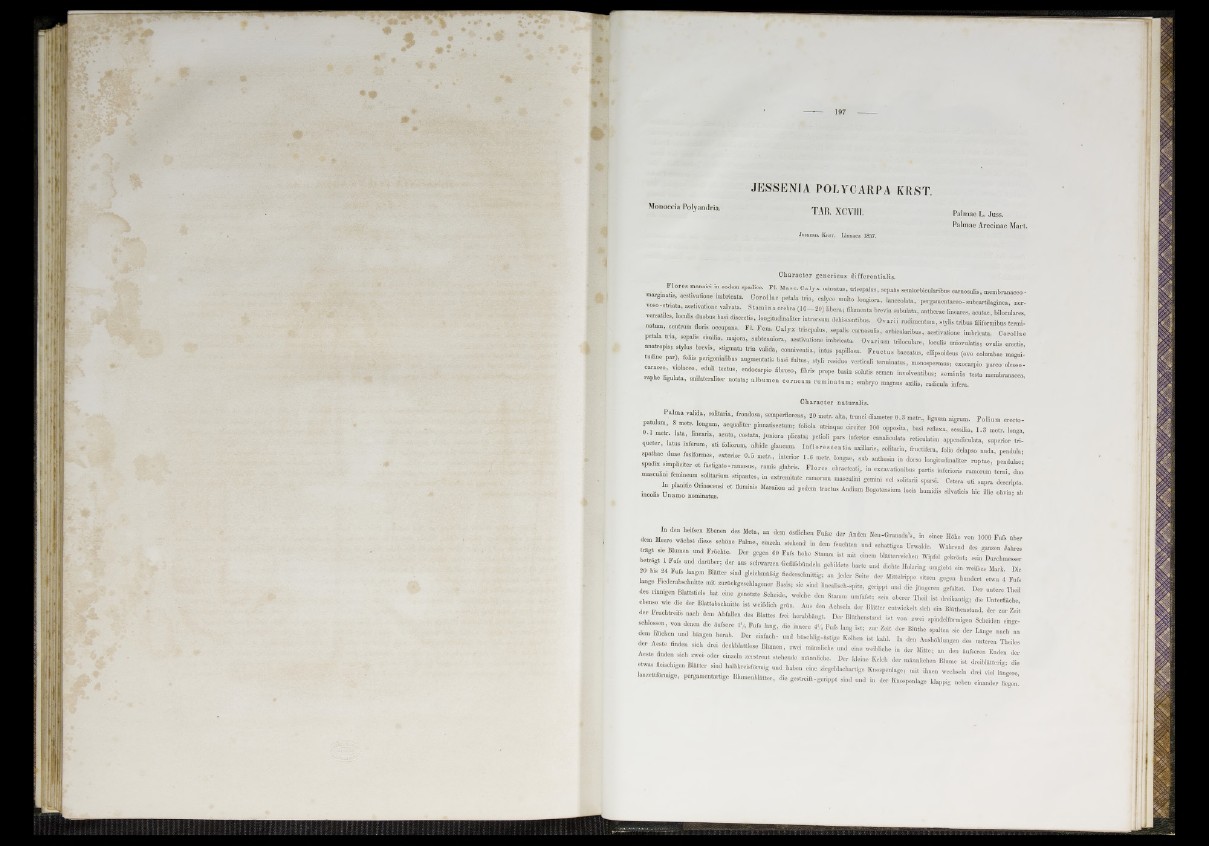
¡I Bl
f f t l !
i t t i .
i
i
i l l
¡ i l l
ill
f l
¡in II
JESSENIA POLYCARPA ERST.
Monoecia Poliandria. TAB XCVI11
J essenia Krst. Linnaea 1857.
C h a r a c t e r g e n e r ic u s d if f e r e n t ia lis .
Pa Im,ac L. Juss.
Palmae Arecinae Marl.
B f l f l ” B Sp8di“ ' ■ M a8°- ° “ Ij,X m in u t e ' semiorbieularibns camosulis, membranaceo-
■ H a' S“™t7 e ° 0r<,11“ '! PeW“ H B "“ Ite '"»Sion., lanceolata, pergamenteeo-subcarfilsginea, ner- — BHHHH “bra D Q bre™ 8“M a ta ’ » » " - » « »"»ares, acntae, biloculares,
n a Z l l f " t ? ’ ,0 ”SÌl"dba!ìlei- totl'°r8am « * ■ ■ » * O v a r ii rudimentum, slylis tribus filiformibuz ternfi-
■ H H H r P“ S' ° aly!£ WSet'a1“ ' Sepd“ “ ■ orbionlaribas, aestivatione imbricate. C o r o lla s
— I— ■ ■ ■ 8“bte»»'“™. S H imbricata. O v a r ium triloculare, loculi, nniovulatis; ovuli, erectis,
— br6™ ’ ?l;S,mata B “ » * » * . '»‘“8 B H b a c c a te , elllpsoldeu. (ovo colmnbne magnil
i — P^ ° “ al'b“8 - w — - « * t a . Stj.ll residuo verticali ie n u iu a t e , monospermos; exocarpio parco oleoso-
I h H ' J f r . “ P1° ’ fibriS F °Pe baSh S0,“a ~ H B i -m i n i s testa uteu.brau.cea,
raphe bgolata, umlaterahter notata, a lb n n ten co rn eu tn r u m in a ,nut. embryo magnos axllls, radícula infera.
C h a r a c te r n a tn r a lis .
uatnlum^s” “ M 2 0 H *"“ » •»»meter 0 .3 m e t ., lignum nigrum. F o liu m ereeto-
0T t e t H S B H H f°M a B H C M t o 100 °PP08ito’ ba8' H sessilia, 1 .3 metr. long*
H H H H h I Ü Ü K 9 PliCatSi P8ti°K P“ 8 - » » » “'»»• retieulntìin appcndlcnlate, superior trispathae
duae L T ” ’ I " '" “ ñ I n í ' ° re8(!e” tU 05:illaris" 5olltoi». fructífera, folio delapso nuda, péndula;
p a t e e duae fu s te ,n o s , extenor 0 .5 mete., interior 1.6 mete, lougae, sub autbesiu iu dorso lougltudlualiter m p ta e , peudulae-
■ — H r * glabris- “ » - — 8 ■ — H
j ~ SOtar‘“m e item ita t e ™ “ Semini vel so lite li sparsi. Cetera utí supra descripta,
inc e li, C n r i ^ T 6t Mara5°" ^ ■ tra° taS B j B° 8“ “ — « ble iffie obvia; ab
In den b e t e n Ebenen des Mete, an dem « s t e h e n Pulse der Anden Nen-Granada's, in einer Hohe von 1000 P u t Ober
t e n Meere wfichst dtese schone Palme , einzeln stehend ln dem feuchten und schattigen D r t e d e . Wahrend d e s “ I L
■ I P T ' ” B H ■D“ SeS■C" 60 ■ “ “ Stam“m !S‘ " S* T - »«'« 't-a.r e ■ich en W ipfel gekrönt; setaDnrehmesser uingiebt ein welfses Mark. Die
I V , , a gleichmäfstg ficdorsclnfittig; an jeder Seite der Mittolrippe sitzen gegen hundert etwa 4 P„fs
ange Fiederabschmtte tmt zurOckgcschlagcnor Basis; sie sind linealisoh-spitz, gerippt und die jüngeren gefaltet. Der untere Thcil
des nnnigen B lattstels hat eine genetete Scheide, welche den Stemm n u t e s t ; sein oberer T h eT is , .W ik a n t e r n T „ - ^
t o T ' U ä ‘f d“ .BI; ‘tabS; bnitte iSt "•°if5lich « « ”■ A” 8 Achseln der Blatter entwickelt sich ein Blüthensland, der I r Zell
W M i i i em A bM en d° 8 Blatte8 frei t a U t e g t Der Blüthenstand ist von zwei spindelförmige, Scheiden eingeschlossen,
von denen die Heisere 1>/, Pufs lang, die innere 4'/. Fufs lang ist- zur Zeit der B l o t e n - f r
dem Püeken und bangen herab. Der einfach- „nd bO s c b lig ltig e ¿ 2 t Z ^ tZ
i S l ü B Ü ^ d7 dMkb,a“ “ e - ™ » weibliche in der Mitte; an den aulseren Enden der
Aeste finden sieh zwer oder emzeln z entrent stehende mannliehe. Der kleine Kelch der mannliehen Blume ist drelblatterig- die
E S S S H “ “ :rCiSl8n"iS ,,,,d d '“ Knospenlage; „fit Ihnen wechseln S W M
lanzettförmige, pergamenten,ge Blumenblätter, die geztt-eift-gerippt sind und in der Knospenlage klappig „eben e i n a n d e r " ^